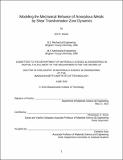Modeling the mechanical behavior of amorphous metals by shear transformation zone dynamics
Author(s)
Homer, Eric Richards, 1980-
DownloadFull printable version (3.883Mb)
Other Contributors
Massachusetts Institute of Technology. Dept. of Materials Science and Engineering.
Advisor
Christopher A. Schuh.
Terms of use
Metadata
Show full item recordAbstract
A new mesoscale modeling technique for the thermo-mechanical behavior of amorphous metals is proposed. The modeling framework considers the shear transformation zone (STZ) as the fundamental unit of deformation, and coarse-grains an amorphous collection of atoms into an ensemble of STZs on a mesh. By employing finite element analysis and a kinetic Monte Carlo algorithm, the modeling technique is capable of simulating processing and deformation on time and length scales relevant to those used for experimental testing of an amorphous metal. The framework is developed in two and three dimensions and validated in both cases over a range of temperatures and stresses. The model is shown to capture the basic behaviors of amorphous metals, including high-temperature homogeneous flow following the expected constitutive law, and low-temperature strain localization into shear bands. Construction of deformation maps from the response of models, in both two and three dimensions, match well with the experimental behaviors of amorphous metals. Examination of the trends between STZ activations elucidates some important spatio-temporal correlations which are shown to be the cause of the different macroscopic modes of deformation. The value of the mesoscale modeling framework is also shown in two specific applications to investigate phenomena observed in amorphous metals. First, simulated nanoindentation is used to explore the recently revealed phenomenon of nanoscale cyclic strengthening, in order to provide insight into the mechanisms behind the strengthening. Second, a detailed investigation of shear localization provides insight into the nucleation and propagation of a shear band in an amorphous metal. Given these applications and the broad range of conditions over which the model captures the expected behaviors, this modeling framework is anticipated to be a valuable tool in the study of amorphous metals.
Description
Thesis (Ph. D.)--Massachusetts Institute of Technology, Dept. of Materials Science and Engineering, 2010. This electronic version was submitted by the student author. The certified thesis is available in the Institute Archives and Special Collections. Cataloged from student submitted PDF version of thesis. Includes bibliographical references (p. 105-110).
Date issued
2010Department
Massachusetts Institute of Technology. Department of Materials Science and EngineeringPublisher
Massachusetts Institute of Technology
Keywords
Materials Science and Engineering.